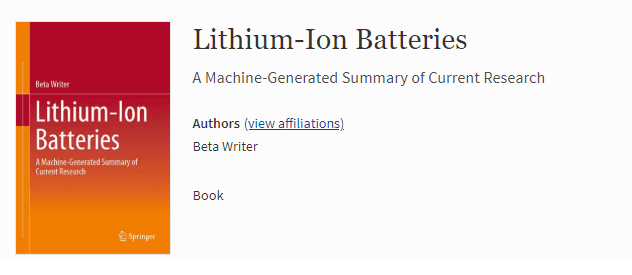Springer Nature publishes its first machine-generated book — a prototype which attempts to gather and summarize the latest research in a very particular field: lithium-ion batteries. While far from being perfect and riddled with incoherent word scrambles, the fact that it exists at all is exciting, and there’s good reason to believe this might soon alleviate some from work from worn-out researchers, enabling them to focus on actual research.
If you’re familiar with scientific writing, you know it can be dense. If you’ve ever tried your hand at it — first of all, congrats — you also know that it’s extremely time-consuming. It’s not your typical article, it’s not a language you would ever use in a conversation. Everything needs to be very precise, very descriptive, and very clear. It takes a very long time to draft scientific texts, and in the publish-or-perish environment where a scientist’s value is often decided by how many papers he or she publishes, many researchers end up spending a lot of time writing instead of, you know, researching.
This is where Artificial Intelligence (AI) enters the stage.
We’ve known for a while that AI has made impressive progress when it comes to understanding language, and even producing its own writing. However, its capacity remains limited — especially when it comes to coherence. You don’t need complex linguistic constructions in science though, and Springer Nature thought it could do a decent enough job synthesizing research on lithium-ion batteries. Thus, Lithium-Ion Batteries: A Machine-Generated Summary of Current Research was born. The book is a summary of peer-reviewed papers, written entirely by A.I.
Technologist Ross Goodwin is quoted in the introduction to Springer Nature’s new book:
“When we teach computers to write, the computers don’t replace us any more than pianos replace pianists — in a certain way, they become our pens, and we become more than writers. We become writers of writers.”
The AI did an admirable job. It was able to scour through an immense volume of published research, extract decent summaries and then put together a (mostly) coherent story. Sure, it’s pocked with sentences which don’t make sense, but it did a pretty decent job while taking virtually no time.
Herein lies the value of this technology: it would, with reasonably small progress, be able to summarize large volumes of dense texts and free up researchers to work on something more valuable.
“This method allows for readers to speed up the literature digestion process of a given field of research instead of reading through hundreds of published articles,” concludes Springer Nature’s Henning Schoenenberger. “At the same time, if needed, readers are always able to identify and click through to the underlying original source in order to dig deeper and further explore the subject.”
The eBook is freely available for readers on SpringerLink.



